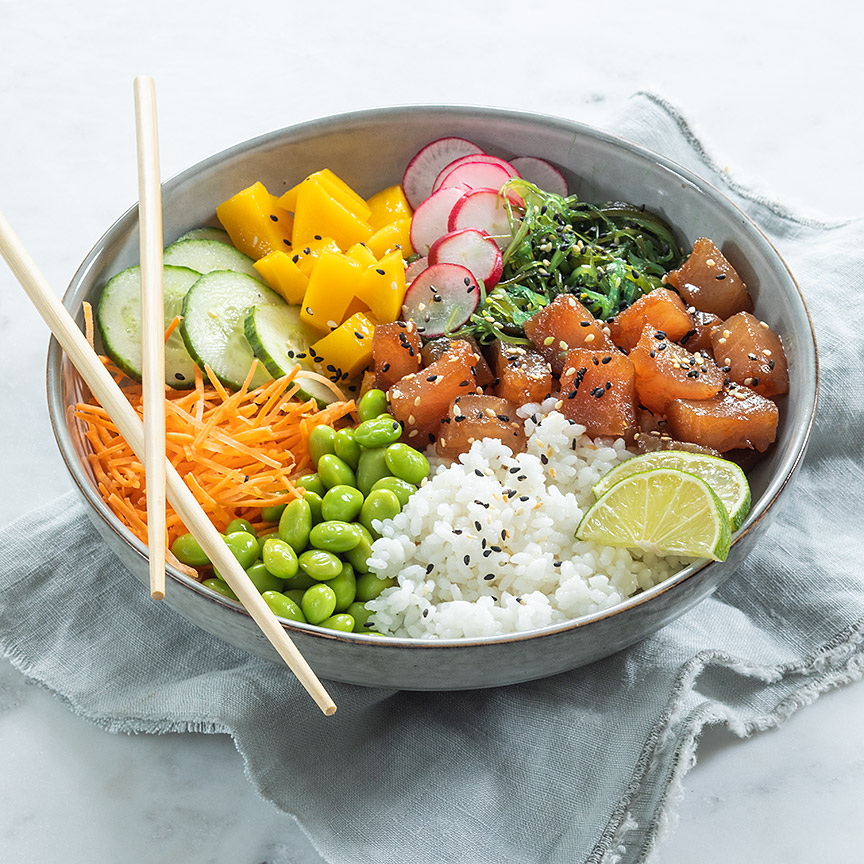1ntroduction to Poke
Poke originated in Hawaii and traditionally consists of bite-sized pieces of raw fish marinated in soy sauce, sesame oil, and other seasonings. The word “poke” means “to slice” or “to cut crosswise” in Hawaiian, referring to the way the fish is prepared. Over time, poke has evolved to include a variety of ingredients, such as rice, seaweed, avocado, cucumber, and other vegetables, creating endless flavor combinations.
Nutritional Profile and Health Benefits
Poke offers a range of nutrients and health benefits, particularly when made with fresh, high-quality ingredients:
Protein
Poke is rich in protein, thanks to its main ingredient of raw fish. Protein is essential for muscle growth, repair, and overall body function.
Omega-3 Fatty Acids
Fish such as tuna and salmon are excellent sources of omega-3 fatty acids, which support heart health, brain function, and inflammation reduction.
Vitamins and Minerals
Poke typically contains an array of vitamins and minerals from vegetables and garnishes, such as vitamin C from bell peppers, vitamin K from seaweed, and potassium from avocado.
Low in Calories
When served without heavy sauces or excessive rice, poke can be a relatively low-calorie meal option, making it suitable for those watching their calorie intake.
Hydration:
Poke often incorporates hydrating ingredients such as cucumber and seaweed, contributing to overall hydration and supporting skin and digestive health.
Potential Risks and Considerations
While poke offers numerous health benefits, there are some potential risks and considerations to keep in mind:
Raw Fish
The consumption of raw fish carries a risk of foodborne illness, particularly if not sourced from reputable suppliers or stored and handled properly. Individuals with compromised immune systems, pregnant women, and young children should exercise caution when consuming raw fish.
Sodium Content
Some poke preparations may be high in sodium, especially if marinated in soy sauce or other salty seasonings. Excessive sodium intake can contribute to high blood pressure and other health issues, so it’s essential to monitor sodium consumption and choose lower-sodium options when possible.
Mercury Levels:
Certain types of fish commonly used in poke, such as tuna, may contain higher levels of mercury. While occasional consumption is unlikely to pose a significant risk, individuals should vary their fish intake and choose lower-mercury options such as salmon or shrimp.
Tips for Making Healthier Poke Choices
To maximize the health benefits of poke and minimize potential risks, consider the following tips:
Choose High-Quality Ingredients
Opt for fresh, sustainably sourced fish and organic vegetables whenever possible to ensure optimal nutritional value and flavor.
Watch Portion Sizes
Be mindful of portion sizes, particularly when it comes to rice and high-calorie toppings such as mayonnaise or fried onions. Stick to smaller portions of these ingredients to keep calories in check.
Go Easy on Sauces
Many traditional poke sauces, such as soy sauce and spicy mayo, are high in sodium and calories. Use these sauces sparingly or choose lighter options such as ponzu or citrus-based dressings.
Incorporate Colorful Vegetables
Load up your poke bowl with a variety of colorful vegetables, such as bell peppers, carrots, and radishes, to boost flavor, texture, and nutrient content.
Experiment with Whole Grains
Consider swapping traditional white rice for healthier alternatives such as brown rice, quinoa, or mixed greens to increase fiber and nutrient intake.
FAQs (Frequently Asked Questions)
Is poke safe to eat?
When prepared and handled properly, poke made with fresh, high-quality ingredients is generally safe to eat. However, individuals with compromised immune systems or specific dietary restrictions should exercise caution, particularly when consuming raw fish.
Can I make poke at home?
Yes, poke can be easily made at home using fresh fish, vegetables, and seasonings. Ensure that all ingredients are properly cleaned and stored, and follow safe food handling practices to minimize the risk of foodborne illness.
What are the best fish options for poke?
Some popular fish options for poke include tuna, salmon, yellowtail, and octopus. Choose fish that are fresh, sustainably sourced, and low in mercury for optimal taste and nutritional value.
Can poke be part of a balanced diet?
Yes, poke can be part of a balanced diet when consumed in moderation and paired with a variety of nutrient-rich foods. Be mindful of portion sizes and ingredient choices to ensure a well-rounded meal.
Is vegetarian or vegan poke available?
Yes, vegetarian and vegan versions of poke, often referred to as “plant-based” or “bowl-style” poke, are available at many restaurants and food establishments. These variations typically feature ingredients such as tofu, tempeh, or marinated vegetables as the main protein source.
How should I store leftover poke?
Leftover poke should be stored in an airtight container in the refrigerator and consumed within one to two days to maintain freshness and food safety. Discard any leftovers that have been sitting at room temperature for more than two hours.
Can poke be gluten-free?
Yes, poke can be made gluten-free by using gluten-free soy sauce or tamari and avoiding toppings such as crispy onions or fried wonton strips that may contain gluten. Be sure to check ingredient labels and inquire about potential cross-contamination when ordering poke from restaurants.
6. Conclusion
In conclusion, poke can be a nutritious and delicious meal option when made with fresh, high-quality ingredients and consumed as part of a balanced diet. Rich in protein, omega-3 fatty acids, vitamins, and minerals, poke offers numerous health benefits, including supporting heart health, brain function, and overall well-being. However, it’s essential to be mindful of potential risks such as raw fish contamination, sodium content, and mercury levels, and take steps to mitigate these risks through safe food handling practices and ingredient choices. By incorporating poke into your diet in moderation and making healthier choices, you can enjoy this flavorful Hawaiian dish while supporting your health and nutrition goals.
- Retinol Peel For Oily Skin In Kingston Upon Thames - May 31, 2025
- Profhilo Treatment Near Esher, Surrey - May 30, 2025
- Redensity 1 Skin Booster Treatments Near Tatsfield, Surrey - May 30, 2025

